HOMECOMING EVENTS
CANCELLED CLASSES
In the early years of Homecoming, classes were often cancelled. For the first 1912 Homecoming, both Friday and Saturday classes were cancelled for the Homecoming festivities. In later years, only Saturday classes were cancelled.
In 1949, students wrote an article in The Daily, asking professors to cancel tests the day before and after Homecoming. They argued the football team was undefeated, so they wanted to be able to enjoy the game, dance, and celebrations. That year, the 630 Club and an army of 3,000 students, played the Iowa State Fight Song on the Knoll and demanded the attention of President Friley. They bargained with the President for classes to be cancelled, and the President agreed to giving the students Friday afternoon off. He also declared the following Monday a holiday, but only if the Cyclones won. This was a typical tradition throughout the 1950s- students eagerly awaited classes to be cancelled depending on the president’s final word and the outcome of the game. In 1965, GSB proposed giving students Monday morning after the homecoming game off regardless of how the team did, and the administrative board approved this suggestion.
This tradition no longer takes place.
DANCES
A Homecoming dance, and sometimes several, took place at Homecoming for many years beginning at that first 1912 Homecoming. The "Fall Gala" dance took place for Homecoming 1912 and for many years after. By 1920, various societies and clubs were hosting their own dances. In 1928, a Homecoming dance took place in the Great Hall of the newly built Memorial Union after the pep rally that Friday evening. Vaudeville acts and specialty numbers were interspersed with the dances. By the 1930s, the Homecoming dance was sponsored by the Pep Club.
Throughout the years, the dances were held in various places on campus including the State Gymnasium, the Great Hall of Memorial Union, and the dances hosted by fraternities, sororities, and clubs were held in their respective locations. Some years there were more than one all-college dance, held one night at the State Gymnasium and the other at the Memorial Union's Great Hall. Sororities, fraternities and clubs often held their dances Saturday evening after the football game. Homecoming Dances would sometimes have a theme. Past themes have included "Alumni First"(1931), "Modern Moments" (1955), "Smoke Dreams" (1956), "Dimensions" (1961), "Voodoo" (1964), "Roman Adventure" (1966) and "A Night of Cyclone Celebration" (2002).
In the 1950s, dances were held in the Memorial Union ballrooms on Friday night with music provided by a live band. In 1950, Iowa State had the rare opportunity to host Louis Armstrong, jazz trumpeter and singer Louis Armstrong, as entertainer for Homecoming. He and his band played at two separate Homecoming dances and the Pep Bar-B-Q. Tickets were sold ($2.60) to see Armstrong and his band play in the Memorial Union as a conclusion to the Homecoming festivities. His visit to Iowa State came shortly after a popular national jazz magazine of the time, Down Beat Magazine, devoted an entire issue to him - a fact that most Iowa State Daily articles reference with pride. The 1950 Homecoming was Armstrong's first visit to the Iowa State campus, but it wasn't his last. Louis Armstrong returned to campus in 1966, taking time to pose for a photograph with Iowa State mascot Cy.
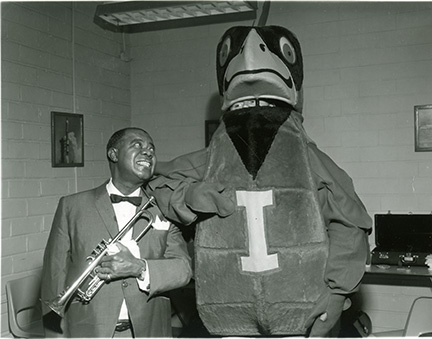
Homecoming dances continued in the 1960s and 1970s. In 1961, the 1,100 tickets sold out in under an hour. In the 1962 Iowa State Daily, instructions for proper attire for Friday and Saturday night activities were included. For the Friday night Pep Bar-B-Que, Pep Rally, and Jazzboree, dress was casual and Bermuda shorts were acceptable. The Saturday night dance was semi-formal, so women were expected to wear cocktail dresses, while the men wore dark suits. In addition to the Homecoming dance after the Saturday football game, throughout the 1950s and 1960s a "Jazzboree" (informal dance) was held n the Memorial Union on Friday night of homecoming week.
Homecoming 1976 featured a Saturday night dance at Hilton Coliseum, with musical guest Les Elgart, who played 40s big band music. He and his orchestra had also visited in 1959, 1961, and 1963. Dances started to give way to concerts, and in 1978 no dance was held.
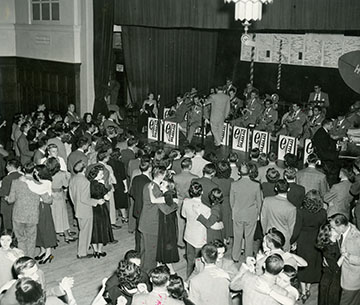 Students on the dance floor at the 1948 Homecoming dance with the Elliot Lawrence band.
Students on the dance floor at the 1948 Homecoming dance with the Elliot Lawrence band.
DECORATIONS
Along with the lawn displays, campus has often been decorated for Homecoming, especially in the very early years when traditions were just beginning. In 1920 the senior civil engineers began a tradition of erecting a "Fight Ames Fight" sign on Beardshear. Arches would be erected at the entrance ways to campus, streamers in color and gold would decorate campus, and often, at least in the early years when campus was smaller, there was a goal to wrap every lamp post and arch in school colors.
Decoration contests took place as well, with many of the residence houses participating. Prizes were often awarded by the Cardinal Guild to the best decorated fraternities, sororities, and dormitories. Divisional clubs (Iowa State was divided into divisions before we became a university; in 1959, the colleges replaced the divisions) were in charge of decorating their respective buildings. Winners for each fraternity, sorority, and dormitory division were announced by the Queen during intermission of the Homecoming dance. Maps of the routes could be found in The Iowa State Daily.
Decoration plans often varied, with new features tried at various Homecomings to help enhance each new celebration. In 1924, a "mammoth A" made of corn was planned at the corner of Lynn Avenue and Lincoln Way. A's (for "Ames") were often placed at one or both of the entrance ways to campus for Homecoming. Welcome arches were also erected to greet returning alumni (in 1928, if not in other years, the arches were filled with corn). By the late 1920s, lamp posts were decorated with colored lights.
Decorations often had themes depicting the opposing team of the Homecoming game losing. For example, in 1953, the Missouri “Tiger” was displayed with titles such as “Tame the Tigers” and “These Little Kittens won’t need Mittens”- a nursery rhyme themed backdrop. The water tower, sidewalks and walls were often painted with signs such as "Beat Oklahoma" or "Beat Iowa".
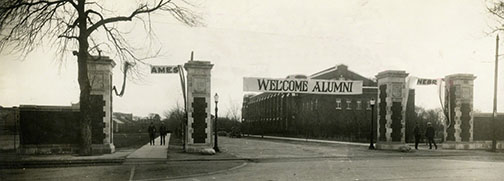 1923 Homecoming welcome sign for alumni when we played the University of Nebraska.
1923 Homecoming welcome sign for alumni when we played the University of Nebraska.
 Theta Gamma Nu's house decorations for Homecoming around 1919.
Theta Gamma Nu's house decorations for Homecoming around 1919.
LAWN DISPLAYS
The lawn displays have been a part of Homecoming tradition since the very beginning in 1912, when “Clean Iowa” and “Sure We Will” were proudly displayed. “Beat Iowa” signs were put up around campus, many by fraternities and clubs. Illuminated signs were even put up on rooftops and porches. By the early 1920s, the lawn displays had moved to campus residences, with a contest included for the top displays. The 1970s and 1980s saw the lawn display come and go as a Homecoming tradition. However, the lawn display tradition, which began in 1912, continues today in 2012. A small variety of the many different lawn displays throughout the years can be seen below.
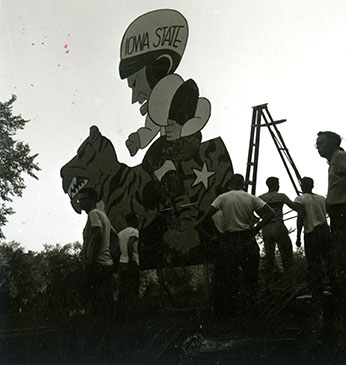 1951 Friley Hall lawn display.
1951 Friley Hall lawn display.
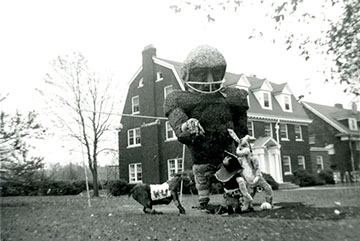 1962 Greek house lawn display.
1962 Greek house lawn display.
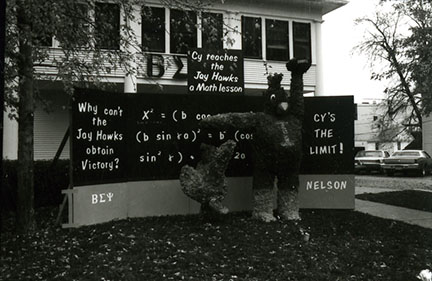 1977 Greek house lawn display
1977 Greek house lawn display
MASS CAMPANILING
Iowa State tradition has long held that a student isn't a true Iowa Stater until he or she has been kissed under the Campanile at midnight. This tradition, known as "campaniling," has evolved over the years. At first, from the early 1900s through the 1970s, campaniling applied to only girls.
"A girl isn't really an Iowa State coed until she has been kissed under the campanile just as the bells toll midnight," wrote the Iowa State Daily in a 1960 article. Girls who were campaniled then later had to give jelly beans to all the other girls in her dorm.
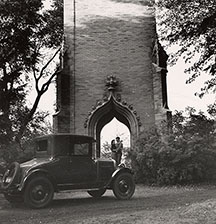 Campanilers.
Campanilers.
Today, campaniling has evolved to apply to every Iowa State student of every gender and jelly beans are no longer part of the equation. But part of this evolution continues today: mass campaniling.
The year 1977 saw Homecoming arrive as any other year, and the evening of Thursday, October 27, 1977, started out as any other Homecoming week night. However, as the bells of the Campanile sounded 11:30 PM, as planned by that year's Homecoming committee, the Iowa State pep band broke the silence of the evening and began to play the ISU Fight Song, marching onto central campus with a group of Cyclones in tow. Cy himself made an appearance, being chauffeured up the sidewalk in the back of a pick-up truck, tossing handfuls of jelly beans into the gathering crowd.
As midnight approached, the crowd grew larger and students lit fireworks as the excitement began to build. Suddenly, on cue, the pep band fell silent and the Campanile struck twelve. 500 students simultaneously kissed one another, and many watched, as they all took part in Iowa State's very first mass campaniling.
The last gong of the low bell of the Campanile sounded out and the pep band resumed, playing the love theme from the then-new hit movie, "The Godfather." Cy packed it up, driving away with empty buckets formerly filled with jelly beans, and the students began to disperse. By 12:30 AM, central campus was empty and silent again. As the Ames Daily Tribune said the next day, the "campanile again stood aloof, and the Indian maidens on the Four Seasons fountain resumed their contemplation of what had once been an ordinary night."
The new tradition of mass campaniling had been born, and thirty-five years later at the centennial celebration of Homecoming in 2012 the tradition continues, as does the evolution: at the present Homecoming, an Iowa Stater can expect breath mints to be passed around to a massive crowd of thousands of students gathered underneath and all around the Campanile, covering most of central campus, to carry on the kissing legacy underneath a shower of fireworks.
PARADE
The first Homecoming parade took place in 1923. The "stunt parade", as it was called then, took place right before the football game that Saturday afternoon on November 17th. Participants in this first parade were given football tickets so that the parade participants could easily enter State field as the final destination of the route. Judges were placed both at the Central Building (now Beardshear Hall) and in the grandstand of State Field itself. The band and "Chips Off the Old Block" also took part in this first Homecoming parade. ("Chips Off the Old Block" were sons and daughters of Iowa State alumni, and in this parade they were designated special arm bands.) The parade participants gathered in front of the Dairy Building at 1:15, and according to the Friday, November 16, 1923 issue of The Iowa State Student, "Promptly at 1:45 the column will move north, going through the campus by way of Margaret hall, Central building, west at Music hall, past Lake Laverne, and up West street to the east entrance of State Field."
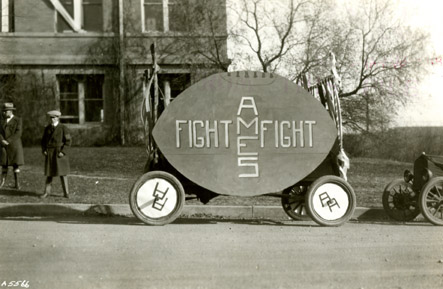 A float from the first 1923 Homecoming parade.
A float from the first 1923 Homecoming parade.
The parade would continue to take place immediately before the Homecoming football game for many years. However, in 1929 a pep meeting was planned for that day and so the parade time was changed to 9:45am in order to encourage participation in the pep meeting. Instead of ending at State Field where the football game would take place, the 1929 parade ended in downtown Ames. Interesting rules would occasionally surface. For instance, in 1925, no float heavier than a Ford car was allowed to participate (we can only wonder why this rule was put into place!).
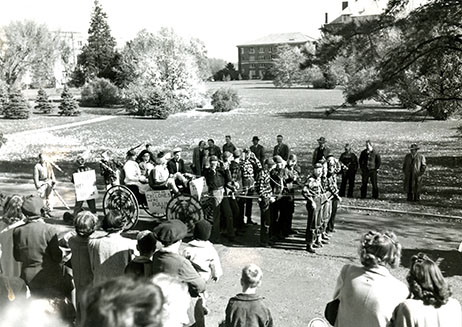 1945 student float, "Pulling for the Cyclones", at the homecoming parade.
1945 student float, "Pulling for the Cyclones", at the homecoming parade.
PAJAMA RELAY
The first annual pajama relay was held during Homecoming in 1940. Teams of four men of varying weights were required to run a relay race, with the twist of all having to wear the same set of pajamas. Each team was sponsored by a women's organization. The weight classes included: less than 130 pounds, 130-160 pounds, 160-190 pounds, and more than 190 pounds. The men were required to run approximately 100 yards in the pajamas. Rules included not being able to roll up the pant-legs or sleeves and having to wear tennis shoes. A gold trophy was given as the prize. The relay was held in centerfield on Clyde Williams Field.
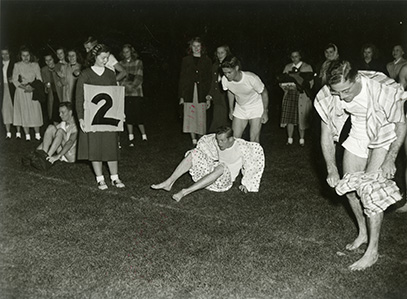 1948 Pajama Relay.
1948 Pajama Relay.
PUSHBALL
Pushball, inaugurated in 1909 as an annual contest between the freshmen and sophomores, was a part of the 1927 Homecoming activities. The sophomore class had not appeared for this annual contest in 1927, which had been originally scheduled to take place two weeks before Homecoming. Harsh punishments were going to be put into place if the sophomores did not appear for this 1927 Homecoming contest, and the sophomores relented, appearring for this first pushball contest Saturday morning before the Homecoming football game. The freshmen won the 1927 match. In 1978, the Homecoming pushball competition was revived. Twelve member teams were created amongst the men's and women's residences. Team members attempted to push the leather-covered ball towards the goal. The pushball competition continued as an annual tradition, usually during the pep rallies, for about a decade before it ceased to take place.
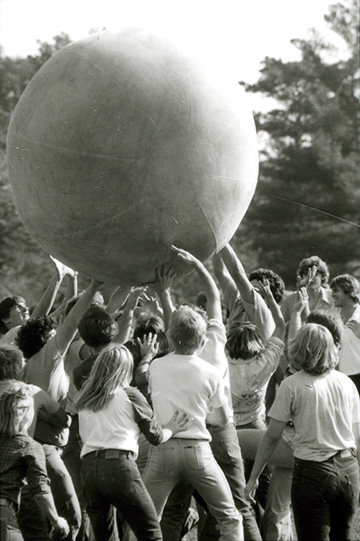 1978 Homecoming Pushball competition.
1978 Homecoming Pushball competition.
HOMECOMING QUEENS AND KINGS, CARDINAL COURT
Homecoming Queen:
The first Homecoming Queen was crowned in 1933 as the "Pep Queen". The winner was Martha "Sally" Jane Puckett. In the early years, Homecoming Queens were crowned at the pep barbeque the night before the football game. Later, they were crowned at the pep rally during Homecoming Week. They had the privilege of attending the Homecoming parade, pep rally, and dance, along with giving out prizes for lawn displays. During halftime of the football game, the queen was introduced to the crowd.
 Crowning of the 1957 Homecoming Queen, Cathy Olson, at the pep rally.
Crowning of the 1957 Homecoming Queen, Cathy Olson, at the pep rally.
Originally, the ladies were nominated by the dormitory or sorority they lived in, and then college-wide elections would be held to select the Homecoming Court. Sometimes, such as in 1937, the football game tickets contained a detachable stub as the ballot. One unique year was 1950, when the opposing football team (The University of Kansas) chose the seven queen finalists. The contest expanded during the 1950s, requiring candidates to participate in interviews, teas, and a fashion review. In the 1970s, a swimsuit contest was added.
 1945 Homecoming queen and attendants riding in a car in the homecoming parade.
1945 Homecoming queen and attendants riding in a car in the homecoming parade.
The Homecoming Queen tradition is definitely not without its controversies. The last Homecoming Queen for a number of years, Diana Herbst, was crowned in 1972. That year, a male student, Rich Talcott, entered the contest. His dormitory nominated him, but used only his initials. Talcott was invited to the candidate tea, but when he arrived with his male escort, the Homecoming Committee refused to seat him, but then changed their mind. However, after the second tea he was out of the contest. He told the Iowa State Daily, "It's not so much that I want to be homecoming queen. I think it's a farce and has been going on too long." Other campus organizations wrote to the editor, arguing that the contest was based only on beauty, and that it increased rivalries between residences. In response to all of the criticism, the position of Homecoming Queen was eliminated the following year.
In 1988, the tradition was brought back, with the addition of a Homecoming King. The winners were selected based on academic achievements, activity involvement, and community service. However, it only lasted for nine years, with the last queen being crowned in 1996 before appearing again ten years later in 2006. Since most of the court members lived in the Greek community, concerns were voiced that winners did not represent the diversity of the student body.
Homecoming King:
The tradition of crowning a Homecoming King began in 1952. The first year featured the king and queen riding in convertibles around the football field and then being awarded football trophies. However, the position of King was eliminated the next year, while the Homecoming Queen contest continued through 1972.
The Homecoming King returned in 1988, along with the Homecoming Queen. Winners were selected according to grades, activities, and community service. Depending on the year, they were either crowned at the Homecoming dance or pep rally. The contest ended in 1997, due to complaints that it was not diverse enough and did not involve alumni.
Cardinal Court:
Once again, the Homecoming Queen and King was reinstated in 2006. A scholarship called the "Cardinal Court Scholarship" was created to honor both female and male students based on academic achievements and community involvement. The tradition continues through the Homecoming Centennial in 2012.
Homecoming Queens:
1933: Martha "Sally" Jane Puckett
1934: Martha Roberts
1935: Beverly Wertz
1936: June Gaylord
1937: Delores Swigert
1938: Kathryn "Kiff" Cooley
1939: Barbara Donald
1940: Margret Anne Clark
1941: Marian Allen
1942: Helen Arnold
1943: Elizabeth Ann Butler
1944: Olive Kelsey
1945: Betha Giffei
1946: Mary Bess Shelledy
1947: Mary Alice Johnson
1948: Mirm Keilman
1949: Margie Slorby
1950: Rita Dunn
1951: Doris Blair
1952: Sue Moore and King: Gilbert Stanek
1953: Pat Nelson
1954: Doris Woessner
1955: Mary Jo "Jody" Dondore
1956: June Brandmill
1957: Cathy Olson
1958: Marcia Christian
1959: Marjorie Waage
1960: Joyce Rice
1961: Roberta Meyer
1962: Kay Kolosha
1963: Karen Wulfsberg
1964: Ann Minert
1965: Adele Berry
1966: Jane Henrikson
1967: Jill Trousdale
1968: Nancy Chase
1969: Joyce Stout
1970: Gwen Frederick
1971: Joann Hansen
1972: Diana Herbst
1988: Nancy Petrick
1989: Cindy Goody
1990: Jennifer Wessels
1991: Melinda Webb
1992: Amy Neece
1993: Ann Bryant
1994: Nancy McGuire
1995: Karleen Hunter
1996: Anh Nguyen
2007:Kimberly Kiraly
2010: Erin Curtis
2011: Krystal Castaneda
Homecoming Kings:
1952: Gilbert Stanek
1988: Tom Bluth
1989: Mark Barnes
1990: Scott Miller
1991: Matt Sopcich
1992: Dwayne Vanderkrol
1993: Thedy Veliz
1994: Steve Sorrel
1995: Judd Hoffman
1996: Troy Blizzard 2007: Luke Johanson
2010: Nate Dobbels
2011: Andy Pringnitz
FIRST STOREFRONT PAINTING 1975
In 1975, campus town merchants came together to coordinate a new event for Iowa State Homecoming: storefront painting. Any off-campus group, residence hall, dorm floor, faculty, or Greek house was eligible to participate, promoting Homecoming in their own unique way. From those who participated, a winner was chosen at half-time during the Homecoming football game and was awarded a free keg of beer.
TORCH-A-THON
In 1981, Iowa State homecoming debuted a new event: the Torch-a-thon. The event, which was an Olympic style relay to Iowa State from the opposing team's university, was run by students and one faculty sponsor. Anyone could sign up to run two six mile segments of the route. In 1981, Iowa State played the Missouri Tigers for Homecoming, so ISU runners began at the University of Missouri Columns and relayed the lit torch the entire 260 miles to Iowa State where the final runner would be joined by ISU mascot Cy, carrying the torch into the stadium during the opening festivities.
Organizers hoped that Torch-a-thon would promote Iowa State spirit while establishing a closer bond between Big Eight schools and attracting attention from students, alumni, and faculty. The Torch-a-thon became an annual tradition, and continued through the late 1990s. During the 1980s farm crisis, each runner raised money in pledges which was distributed to agriculture students who had been affected by the crisis. While it was an Iowa State Homecoming tradition, the Torch-a-thon was the longest collegiate marathon of its type in the nation.
POST-GAME ACTIVITIES
After all the fun of the game and pre-game activities, what homecoming celebrations have happened after the game? An Alumni Coffee Hour took place for many years during the 1950s through 1970. There were also Campanile tours, water shows by the ISU swim team, an Alumni Student Seminar (the topic in 1970 was “ISU, An Education!”), and a semi-formal dance. Student dances and celebrations took place as well, and continue to this day.